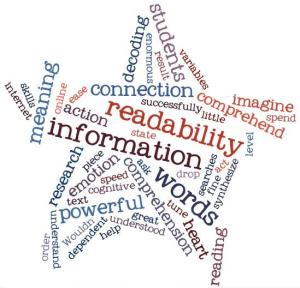Readability may be defined as ‘reading ease’ or  how content can be successfully understood. Teachers know that comprehension is dependent on many variables, one of which is the readability level of information whether online or in print. It matters little if you have the best list of websites for research but the students have difficulties in decoding or understanding the information. When students expend enormous cognitive energy in decoding words, the result is a drop in reading speed, comprehension and higher order thinking skills.
how content can be successfully understood. Teachers know that comprehension is dependent on many variables, one of which is the readability level of information whether online or in print. It matters little if you have the best list of websites for research but the students have difficulties in decoding or understanding the information. When students expend enormous cognitive energy in decoding words, the result is a drop in reading speed, comprehension and higher order thinking skills.
If you ask students where they find information, they will probably say ‘the internet’. Wouldn’t it be great if you could help them fine-tune their searches so that it accommodates their reading levels? Google has done just that – click on the Advanced Search. 
 Record your search terms (eg. “digital writing”). In Reading Level: select ‘basic, intermediate or advanced‘ results. The selected reading level will filter websites that belong to that level. As well, a graph will display the percentage of websites that are assigned to each level.
Record your search terms (eg. “digital writing”). In Reading Level: select ‘basic, intermediate or advanced‘ results. The selected reading level will filter websites that belong to that level. As well, a graph will display the percentage of websites that are assigned to each level.
Readability tools can be found online or as part of writing software. Each one focuses on specific algorithms to determine the reading level. Consider using these to support your students:
- Juicy Studio: Readability of Websites
- Added Bytes – Check Text Readability
- Intervention Central (passage generators – with readability scores)
- OKAPI! Readability Statistics and Reading Probe Generators
- The Readability Test Tool – 3 options
- Readability add-on for Firefox
- MS Word Readability tool (site provides a simple explanation)
I’d be interested in any comments from anyone who has used these tools or would like to use these tools with their students. How did you use them; your thoughts around this.


